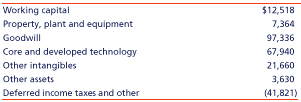|
||
|
The Company hedges its foreign currency exposures by entering into offsetting forward exchange contracts and currency options, when it deems appropriate. The Company also occasionally enters into interest rate swaps, interest rate caps, interest rate collars, and forward rate agreements in order to reduce the impact of fluctuating interest rates on its short-term debt and investments. In connection with issuances of long-term debt, the Company may also enter into forward rate agreements in order to protect itself from fluctuating interest rates during the period in which the sale of the debt is being arranged. The Company accounts for derivative financial instruments using the deferral method of accounting when such instruments are intended to hedge an identifiable firm foreign currency commitment and are designated as, and effective as, hedges. Foreign exchange exposures arising from certain receivables, payables, and short-term borrowings that do not meet the criteria for the deferral method are marked to market. Resulting gains and losses are recognized currently in Other (expense) income, net, largely offsetting the respective losses and gains recognized on the underlying exposures. The Company designates its interest rate hedge agreements as hedges of the underlying debt. Interest expense on the debt is adjusted to include the payments made or received under such hedge agreements. Any deferred gains or losses associated with derivative instruments, which on infrequent occasions may be terminated prior to maturity, are recognized in income in the period in which the underlying hedged transaction is recognized. In the event a designated hedged item is sold, extinguished or matures prior to the termination of the related derivative instrument, such instrument would be closed and the resultant gain or loss would be recognized in income. Stock-Based Compensation Under the provisions of Statement of Financial Accounting Standards (“SFAS”) No. 123, “Accounting for Stock-Based Compensation,” the Company accounts for stock-based employee compensation using the intrinsic value method prescribed by Accounting Principles Board Opinion (“APB”) No. 25, “Accounting for Stock Issued to Employees,” and related interpretations. Accordingly, compensation cost for stock options is measured as the excess, if any, of the quoted market price of the Company’s stock at the date of the grant over the exercise price. Start-up Costs In April 1998, the American Institute of Certified Public Accountants issued Statement of Position 98-5 “Reporting on the Costs of Start-Up Activities.” The Company is required to adopt the provisions of this Statement no later than its fiscal year 2000. This Statement provides guidance on the financial reporting of start-up and organization costs and requires such costs, as defined, to be expensed as incurred. Adoption of this Statement is not expected to have a material impact on the Company’s results of operations or financial condition. During fiscal year 1999, the Company acquired 10 businesses for an aggregate of $381,530 and 357,522 shares of the Company’s stock. The Company also granted options to purchase 73,074 shares of the Company’s common stock to eligible employees of one of the acquired companies. The 1999 results of operations included charges of $48,800 for purchased in-process research and development in connection with three of these acquisitions. These charges represented the fair value of certain acquired research and development projects that were determined to have not reached technological feasibility and do not have alternative future uses. Unaudited pro forma consolidated results after giving effect to the businesses acquired during fiscal 1999 would not have been materially different from the reported amounts for either 1999 or 1998. Included in 1999 acquisitions is the purchase of Clontech Laboratories, Inc. (“Clontech”), which was completed in August, for approximately $201,000 in cash, subject to certain post-closing adjustments. In connection with this acquisition, a charge of $32,000 for purchased in-process research and development was included in the results of operations for the Biosciences segment, as noted above. The estimated fair value of assets acquired and liabilities assumed relating to the Clontech acquisition, which is subject to further refinement, is summarized below, after giving effect to the write-off of purchased in-process research and development:
Intangibles related to Clontech are being amortized on a straight-line basis over their useful lives, which range from 10 to 15 years. During fiscal year 1998, the Company acquired six businesses for an aggregate of $545,603 in cash and 595,520 shares of the Company’s common stock, or 297,760 shares on a pre-split basis. Included in 1998 acquisitions is the purchase of the Medical Devices Division (“MDD”) of The BOC Group for approximately $457,000 in cash. In connection with this acquisition, a charge of $30,000 for purchased in-process research and development was included in the 1998 results of operations. This charge represented the fair value of certain acquired research and development projects that were determined to have not reached technological feasibility and do not have alternative future uses. Intangibles related to MDD are being amortized on a straight-line basis over their useful lives, which range from 15 to 25 years. |
||
|
|
|
|
